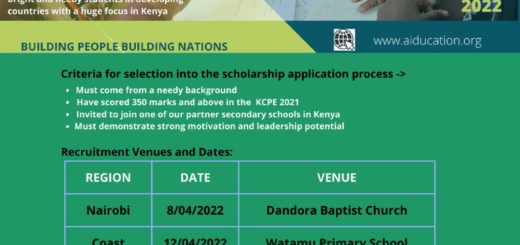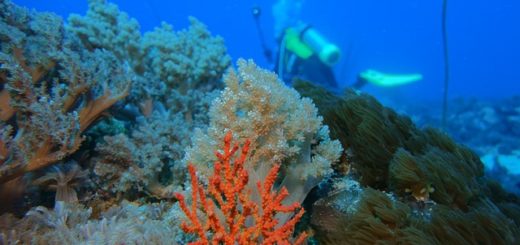Terms of Reference for Feasibility Study on Improved Resilience for Rural Populations in the Semi-Arid Lands of Laikipia County
Habitat for Humanity Kenya (HFHK) is seeking the services of a consultant to conduct a Feasibility Study for a potential project targeting 7 villages within the Solio Resettlement Scheme in Laikipia East Constituency. This will support in adjustments or replacements on the perceived components of the project including the location. Water for Multiple Use (drinking, food security, health, social structures), is emerging as the possibility for enhancing the resilience of the target population.
1. Background and Rationale
Habitat for Humanity Kenya (HFHK) is among the 70 country affiliates of HFH International (HFHI). We report to the Africa Area Office (AAO) together with other 8 National Organizations (NOs). In Kenya, we were registered in 1982 as Non-Governmental Organization, with the goal of enabling low-income families access decent and affordable shelter. In the last 40 years, HFHK has supported more than 345,000 families across 9 counties in Kenya through housing micro-finance and direct construction. We are currently operating in Laikipia, Homabay, Kisumu, Tana River, Machakos and Makueni. Our current Business Plan (2020-2025) has outlined four programmatic areas, namely: Financing for Owner-led Construction (FOC); Settlement-Based Practice (SBP); Secure Land Tenure (SLT); Disaster Risk Reduction & Response (DR3). HFHK’s programs has been based in Laikipia County since 2015, with a portfolio of interventions on Home Construction, Water Sanitation and Hygiene (WASH), Schools Infrastructure, Table Banking, Land Rights and Cash transfers. Over the period, our presence was heavy in Laikipia North Constituency where more than 10 donor funded projects were implemented. As part of initiatives for enhancing resilience of communities in the Arid and Semi-Arid Lands (ASALs), we are exploring the possibility of designing a new project for BMZ funding. The project is aimed at enhancing access to safe drinking water and increased income for rural populations in Laikipia County. The proposed project is exploring a Theory of Change on Economic empowerment (increased income)’ being delivered to ‘rural populations’ through ‘access to water” for drinking (homes and school), farming (livestock & irrigation), health (sanitation and hygiene) and improved social structures (cooperatives). Below is the emerging project design:
Goal
- Improved resilience to drought, hunger, health risk and socio-cultural barriers by 19,850 rural population in Solio Resettlement Scheme
Long Term Outcomes
- 3,970 low-income households across 7 villages are economically empowered to meet their basic needs
Intermediate Outcomes
Water for Multiple Use
Community
- 7 existing boreholes solarised for livestock and domestic use
- 7 new solarized boreholes provided for SMART farming
- Water Management Structures improved and linked to WRUAs
7 Primary Schools
- Rainwater Harvesting
Sanitation and Hygiene
7 Primary Schools
- Handwash stations
- Girls Friendly Latrines
- Girls clubs implementing Manstrual Hygiene Management
- Health Clubs implementing CHAST approach
3,970 Households
- Resilient Latrines
- Outreach through CHVs applying PHAST approach
Business Models
Community
- Cooperatives
- Income diversification
Women
- Financial literacy training
- Group Savings & Loans
- Livestock exchange program
Youth
- Vocational skills
- Sanitation Marketing
- Drip kits marketing
- Marketing roof gutters for water harvesting
Advocacy and Collaboration
Households
- Purchase of drip irrigation kits from the youths
- Purchase of sanitation materials from the youths
- Purchase roof gutters from the youths
State Actors
- Technical support and co-financing
Non-State Actors
- Cluster Meetings
- Shared interventions
Solio Resettlement Scheme is being considered for this new project. Established in 2009, Solio Ranch Resettlement Scheme is in Laikipia East Constituency. This is the place where Internally Displaced Persons (IDPs) evicted from the forest in 1989, were resettled by the Government on a 15,000-acre parcel of land bought from Solio Ranch. The settlement scheme is currently hosting more than 3,970 families originating from the slope of Mt Kenya (Chehe, Hombe, Ragati and Kagochi) and the Aberdare Ranges (Zaina, Kabage and Gakanga). Each household was given 4 ½ acres, which includes the detached ½ acre for homes and 4 acres for farming. Both the homes and farmlands are clustered in one place, making it possible to provide shared services. There are seven villages in the scheme (Furaha, Rehema, Bahati, Tetu, Mathingira, Makandamia, Baraka). The last 5 years have witnessed investments towards the provision of water in the settlement scheme. Through a project co-funded by the county government of Laikipia and Water Sector Trust Fund (KES 143 million), access to clean and safe water for domestic use, is progressively being provided to the 7 villages (19,850 people, 11,040 grade cows, 22,380 goats), 7 primary schools (2,240 pupils), 2 secondary schools (160 students,) and 1 health centre among other facilities. Initially, this area was a swathe of treeless land, but today, villages are planting trees and keeping livestock. The county anticipates that the provision of water will enable the growing of oranges, onions and vegetables within the Solio belt, establishment of quality beef through feedlots technology and increased dairy production. They also foresee impacts of increased incomes and improved living standards for scores of families that lived in abject poverty.
Laikipia County is ranked as the 15th largest county in the country, covering a land area of 9,532 KM2, with a projected population of 615,925 persons by end of the year 2022. The county is largely rural in settlement with the main economic activities being crop farming, livestock rearing, tourism, retail and wholesale trade. The annual average rainfall varies between 400mm and 750mm. Approximately 20% of the total county’s land area is considered high and medium potential land, suitable for crop farming, while the remaining 80 % is low potential and suitable for livestock and wildlife. There are 7 distinct land use patterns heavily influenced by the climatic conditions and the ecological zones. These include pastoralism, mixed farming, irrigated cultivation, ranching, among others. However, the county is dominantly a pastureland with 46 large-scale private ranches occupying more than 50% of the total land area in the county. Laikipia has witnessed the emergence of squatters and new settlement schemes. Currently, there are about 4,712 squatters in the county. The squatters’ problem hinders the realization of improved lives for all. The county Human Poverty Index (HPI) stands at 57.3, which is high, compared to the national HPI of 29.1. The distribution of water sources is uneven across the county with the northern parts experiencing serious water shortages. While 14% of households access water from within their dwellings, more than 50% of the households take over 20 minutes to reach the nearest water point (6% taking over 1 hour). Boreholes, water pans, dams, shallow wells, springs and sub surface dams are a common feature in the county as soruces of water for domestic and irrigation purposes. Rock catchments in the northern parts of Laikipia are increasingly being exploited. There are 29 Water Resource Users Associations (WRUAs) that run water resources across the county. Laikipia is drained by the Ewaso Ng’iro River and its tributaries, which originate from Mt. Kenya and the Aberdares. On human waste disposal 72.8% of households use pit latrines while 11.3% still practice open defecation. The county is comprised of five administrative sub counties (Laikipia East, Laikipia North, Laikipia West, Laikipia Central and Nyahururu) and three constituencies (Laikipia East, Laikipia West and Laikipia North).
2. Purpose and Objectives
In July 2022, the initial project ideas from HFHK received an A-priority rating from BMZ. Consequently, HFHK and the County Government of Laikipia (CGL), conducted a joint scoping mission across the 7 villages of Solio Resettlement Scheme in preparation for a Needs Assessment and Proposal Development. The components of this proposal will be subjected to a Feasibility Study in order to shape the final design. Below are the timelines of major events occurring prior and during the phase of the Feasibility Study:
- Scoping/validation mission- Dec 5-7 (Completed)
- Needs Assessment Exercise- Dec 19-31 (Ongoing)
- Proposal & Budget- Jan 3-13 (Preparing)
- Feasibility Study- Jan 16-20 (Not Yet Started)
This consultancy is only for the Feasibility Study only. The specific objectives for this task, are outlined Below. The consultant for the Feasibility Study is required to undertake the following:
- Based on BMZ guidelines, conduct the Feasibility Study of a Project being co-designed by Habitat for Humanity Kenya and the County Government of Laikipia
- Determine the relevance, appropriateness and quality of the project design by measuring the extent to which the project is suited to the priorities of the target group and national development priorities, including changes over time
- Establish the effectiveness of the proposed project by elaborating the extent to which the project shall achieve what it has set out to do
- Evaluate the efficiency and cost-effectiveness of the proposed project by exploring whether the most efficient process has been adopted in achieving the outputs in relation to the inputs (costs, both financial, staffing, time) and whether funds are being invested in the least costly way in order to achieve the desired results.
- Predict the impact of the project by assessing the positive and negative consequences of the project activities, direct and indirect, intended and unintended
- Ascertain the sustainability by clarifying how the intervention will continue to deliver benefits for an extended period after completion. The project needs to be environmentally, financially and socially sustainable
- Determine the capacity of Habitat for Humanity Kenya to successfully implement the project
- Provide solid basis for finalizing the BMZ Proposal and Budget being prepared by Habitat for Humanity Kenya, by clarifying conditions, opportunities and risks that should be considered to improve effectiveness of projects and avoid mis investments
- Consolidate a Feasibility Study Report of not more than 15 pages with the structure and content that meets the standards of BMZ.
3. Scope of Work
The focus, scope and depth of feasibility studies should be geared towards the complexity and scope of the planned project and the political, economic and cultural context. It should provide an analysis of the problem situation and of the target group and stakeholders, including a baseline study and subject the planned project to a critical examination based on the OECD’s DAC criteria. Recommendations should be formulated based on relevance, effectiveness, efficiency, impact and sustainability. Specifically, the Feasibility Study Report should answer the following questions:
Relevance
- Will the planned project approach address an important development problem or a key developmental bottleneck in the partner country or region?
- Is the planned project geared towards the needs of the target groups?
- Which change is to be brought about by the project after it has come to an end?
Effectiveness
- Are the measures and the chosen methodological approach suitable for achieving the project objective?
- Should activities be planned at the meso and/or macro level (multilevel approach) in order to increase sustainability?
- To what extent will use be made of synergy effects with measures undertaken by other donors or programmes?
- Which measures does the study recommend for achieving the objective?
- Which impact logic/impact hypothesis should the project be based on?
- What form could an effective results matrix take, including suitable and reliable indicators (submission of first rough draft with indicators and baseline data)?
- Who monitors the effects when and at which intervals (effectiveness monitoring)?
Significance
- Which objectives and effects derived from the problem/needs analysis should be achieved for which target group?
- To what extent does the planned project build structures, set examples and have a broad impact? Is a multilevel approach (micro, meso and macro level) a good way to increase significance and effectiveness?
- To what extent does the objective consider, inclusive gender, culture- and conflict sensitive aspects and those based on human right
Sustainability
- How can the sustainability of the results and effects be ensured and strengthened (structurally, economically, socially and ecologically)?
- Which role/responsibility is assumed by state and/or civil society structures? To what extent can local potential, structures and procedures be built on? Which measures and instruments are most suitable for harnessing and strengthening local initiative, participation and capacities?
- Which sociocultural barriers exist about this approach and how can these be overcome?
- Which negative consequences and effects could project measures or sub-objectives bring about? To what extent can this be considered in the project (concept) e.g., “do no harm” approach, conflict-sensitive effectiveness monitoring, etc.?
- Which risks (personnel risks for those implementing the project, institutional and reputation risks, context risks) exist when implementing the project? How can these be minimized?
This information will be fitted on the BM Sample Report structure, that will be provided to the consultant (maximum 15 pages). BMZ has also designed a guide to help in conducting feasibility studies
4. Methodology
The Feasibility Study is designed to collect quantitative and qualitative data will through a Desk Review, Focus Group Discussions (FGDs), Key Informant Interviews (KIIs), Household Survey (Questionnaires by Enumerators), Project Site Observations and Stakeholders Workshop. There will be two sources of data:
Secondary Data
- Socioeconomic, political and cultural context of Laikipia County and the Project Location
- Initial situation in the sectors being addressed by the components of project within the location
- Problems identified by the proposed project, the causes of these problems and how they affect the living situation of population groups
- Needs derived from the problem analysis and how this determined
- Background and history of the planned development measures and impact logic
- Alternatives to the planned project or its individual components
- The relationships of the planned project with the government’s development strategy
- The make-up of the target group (gender, ethnic origin, age)
- Prior experiences from similar projects, other studies and analyses
- The historical interests of stakeholders and evidence on conflicts of interest
- The capacity offered by Habitat for Humanity Kenya and County Government of Laikipia (institutional, technical, personnel and financial) and measures necessary for strengthening
- Agreements in place between stakeholders in Laikipia County
Primary Data:
- How homogenous or heterogeneous is the target group and what extent must the project take this into account in the selection of beneficiaries
- Needs of the target group members and how can these be addressed in a social context considering their roles
- Conflicts of interest with other population groups that may arise through this funding
- The target group’s potential which can be boosted with regard to its own initiative, self-help efforts and local problem-solving capacities
- The most important stakeholders (state and non-state actors) in the project’s sector and location
- Existing interactions of target group with other stakeholder projects and how they can find their way into the project concept
- Whether stakeholders have a common understanding of the problems and if they have derived project objectives from this common understanding
- The level of stakeholders’ support for the project and ways can they influence the project and to what extent
5. Deliverables and Timing
The expected outputs for this consultancy include the following:
- 15-page Feasibility Study Report
- Stakeholder Workshop Report
The consultancy is expected to take 18 days, staggered between the 16th of January 2023 and the 10th of February 2023. The consultant is expected to work very closely with the management of Habitat for Humanity Kenya and the County Government of Laikipia conducting the Feasibility Study. The deliverables of this assignment are as follows:
- Online Inception Meeting-0.5 days
- Briefing of consultant, review of relevant documents and development of tools-2 days
- Inception Report-1.5 days
- Data collection (field and desk research)-5 days
- Data analysis and preparation of 1st draft report-3 days
- Feedback from HFH Kenya and HFHD-1 day
- Preparation of the 2nd draft report-1 day
- Stakeholders Validation Workshop and Report-2 days
- Finalisation and submision of the final-2days
6. Qualification and Experience
The potential Consultant should be knowledgeable on Feasibility Studies of integrated development projects targeting rural populations in Arid and Semi-Arid Lands (ASALs). The following qualifications are essential:
- Advanced Degree in rural water enterprises, smart agriculture, environmental health, agribusiness, resettlement schemes, climate change adaptation, project management, international development or a related field
- 10 years’ experience and above in conducting Feasibility Studies
- Familiarity with the BMZ guideline for conducting feasibility studies
- Extensive expertise and experience in water for multiple use systems
- Demonstrable expertise in working with government through the devolved structures
- Proven record of carrying out similar tasks in the Arid and Semi-Arid Lands
- Excellent track record in designing and conducting quantitative and qualitative research, analysis and evaluation
- Ability to provide strategic recommendations to key stakeholders and influence responsiveness on the same
- Excellent interpersonal and communication skills including ability to facilitate and work in a multidisciplinary team
- Proven ability to conduct high quality research, meet deadlines and respond to requests and feedback provided timely and appropriately
- Strong analytical skills and ability to clearly synthesize and present findings
- Ability to draw practical conclusions and to prepare well‐written reports in a timely manner and availability during the proposed period
Ability to fluently speak the local language (Swahili) will be an added advantage.
7. Application Process and selection
The application is open to individual consultants or firms. Applicants must provide:
- A proposal clearly showing the following:
- Approach and methodology for meeting the objectives of this assignment
- Number of days it would take to complete this assignment
- Detailed work-plan based on the scope of the Consultancy and methodology
- Financial proposition showing all the expenses, inclusive of 5% withholding Tax (Consultant fee, cost of enumerators, accommodation, road transport)
- A detailed CV and professional background relevant to the assignment
- Firms are required to provide their company profile with Registration Certificates, Tax Compliance Certificate and detailed CVs of their members
- At least three references for relevant assignments delivered in the past
Each team member, incl. interpreters, enumerators etc. need to fully comply with and sign HFH Kenya’s Conflict of Interest and Safeguarding Policy as well as commitment to data security and privacy.
Applications should be submitted to:
The Procurement Officer
Habitat for Humanity Kenya
office: 0101 454 380
Email: procurement@hfhkenya.org
Deadline: 5th January 2023








